
Car Extrication training:
Car extrication is when you have to free
a person or more than one person that is trapped in a motor vehicle as a result of a motor vehicle accident. For car extrication
training we used an old car that was in perfect condition but no one wanted anymore. All of us, including Brad Witte (Albert
Lea Firefighter and Albert Lea Fire Explorer leader) were in full bunker gear. If you dont know what bunker gear is, there
is a picture with text at the bottom of this web page that will explain it to you. First of all, we placed two wooden car
stops right behind the front tires so that the car wouldnt roll. We then took the halligan bar; there is a picture at the
bottom of this web page that shows you what the halligan bar looks like, and popped the tires of the car. This also helps
to reduce the chance of the car rolling. Then, we used wire cutters to cut the wire to the battery of the car and bent it
back away from the battery. We did this so if there had been air bags it would be less likely theyd go off and further injure
the victim. After that, we used the center hole punch, a little tool that looks like a pen, pressed it against the corners
of the windows and right away they broke into little pieces. We then used the flat-headed axe to cut half of the front windshield;
we did this by lightly chopping the windshield near the frame of the car. We cut the half with a saw (to see how they both
work). The front windshield then came out in one piece. Brad Witte used the Jaws of Life (theres a picture directly above
this text that has a firefighter using the Jaws of Life to pry open the door on a car) to pry the doors of the car open then
off. Meanwhile, we watched to see how they work. After that, we used a saw to cut the frame of the roof off. When we got the
roof cut loose, we folded it over the back end of the car. If this had been a real accident, it wouldve been easier to free
the victim(s) with the roof folded over and the doors cut off. Then we cut the seatbelts using a little metal bade with a
plastic handle. If this had been a real car accident, we wouldve covered the victim(s) with a blanket before breaking any
of the windows, cutting the doors, and cutting/folding over the roof.

Aerial Ladder training:
The aerial ladder is the
ladder that is attached to the top of a fire truck and usually goes up to some where around 100 feet. It is controlled from
the base of the ladder, which is on top of the fire truck. Our aerial ladder can go up to 105 feet, turn a full 360 degrees
at any height and at almost any angle, it can turn, rise and decrease at different speeds (you can control it) and it can
hold up to 500 lbs. When you go up you wear a harness that is around your waist and when you reach the height you want to
be at you hook the harness (which is attached to you) on one of the rungs. This prevents you from falling off. What we did
is, we had the ladder all in sections (not stretched out) and we had David Moen (Albert Lea Firefighter) at the top of the
ladder. We then climbed to the top, when we got all hooked in David Moen used his radio and radioed down to Al Shallock (Albert
Lea Firefighter) that we were ready. Then, Al Shallock raised the ladder up (kind-of fast, but not too fast). If at any time
we felt like we didnt want to go any higher, David radioed Al and he stopped it. If you didnt feel uncomfortable then they
raised you up to the full 105 feet (at a 60 degree angle). After it was up to the full length you got to stand up there for
a while and look around, then they lowered the ladder back down and you got off. We are also going to be spinning and being
moved up and down, both fast and slow. We werent in full bunker gear this time; because it was 91 degrees Fahrenheit outside
but we will be usually do training in full bunker gear. To find out what bunker gear is you can look at the bottom of this
page and there will be a picture and some text explaining it to you.

Forcible Entry:
To practice forcible entry, we went to some old houses we use for training purposes. While
there we used a halligan bar (there is a picture of a halligan bar at the bottom of this web page) and a flat-headed axe.
We closed and locked some of the doors in the house then, one of us took the halligan bar and placed it in the crack between
the door and the wall. Another one of us took the flat-headed axe and (using the end of it, not the sharp part of the blade)
we pounded the end of the halligan so it would go in further. Then the person holding the halligan bar pulled on the bar and
tried to get the door open. We also took the axe, found a weak spot in the walls and made a hole in the wall big enough
for us to fit through. Also, we took the pike pole (a long pole with a hooked point on the end of it) and practiced making
hole in the ceiling. All of us were in full bunker gear but not SCBA's this time. Even though next time we will be using SCBA's.
To find out what and SCBA and bunker gear is, look at the bottom of this page, a picture with some text will explain it to
you.

Hose
Maze:
The hose maze is a training procedure designed to teach you how to use your hose line to
find your way out of a burning building. First, we took SCBA masks and put duct tape over the front of them, so, you couldnt
see out of them. Then we took a bunch of 1½-inch hoses and hooked them together with a nozzle on the end and a coupling in
the middle of them. We then took the hose (all the hoses put together) and put it going into a pitch-black room (one with
lots of room and other stuff in it). We filled the hose up with gas (like CO2), so, it would be filled up and easier to hang
on to. We then placed the nozzle of the hose in one area of the room and put the rest of the hose going over and around stuff.
We then put on all of our bunker gear our SCBAs (but you dont have to have air on). We went in groups of 2, one person was
in front and had to keep hold of the hose at all times so you didnt get lost and they gave the commands. The other person
was behind the 1st person and hung on to the boot of the person in front of them. One of the firefighters took
both you and your partner into the pitch-black room and brought you to the coupling. The leader had to determine by the feel
of the coupling, you do this by determining which end of the coupling has wide 3-D lines going across it (that end leads you
to the nozzle, which means you are going deeper into the fire when you want to be going out of the fire), the other end has
small, little 3-D lines going across it (this end leads you to the doorway you entered, which is where you want to go). After
you determined that you and your partner follow the hose line around and over the stuff and if you went the right way you
will end up back in the doorway you entered from, which means you got out of the burning building. You do all this in pitch-blackness;
so, it takes some practice to get used to it. If you want to find out what the
SCBA or Bunker Gear is, you can look at the picture and information located at the bottom of this page.
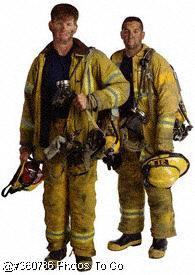
Running Stairs:
Everyone has to be in full bunker gear, not SCBA (to find out
what bunker gear and the SCBA are see the picture and text at the bottom of this page). Then you line up in single file. You
go one at a time. When it's your turn you run to the stairs go up until they stop (2 stories) then you go across and there's
a another stairway that leads up to the 3rd floor, you run up these stairs then you run back down and go to the back of the
line. There's one firefighter at the top of your last stairway. And there's one firefighter down at the bottom where you start.
You will do this a number of times before you're done. After you've done this training a lot and are used to it they
will start to gradually put more weight on you.
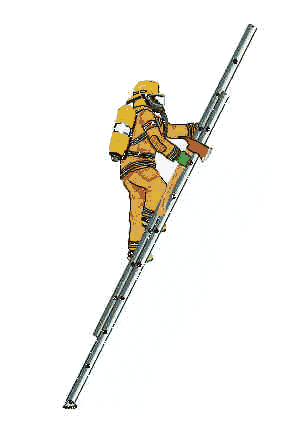
Ladder/Roof training:
First of all everyone has to be in full bunker gear, but not SCBA (to find out what bunker
gear and SCBA is or what bunker gear is see the picture and text at the bottom of this page). We first practice carrying and
putting up the regular ladder with 2 people then with 4. Then we practice putting up and carrying the roof ladder with 4 people. While
you're setting up these ladders you have to make tons of contact with the person (people) at the other end of the ladder.
The people that are at the foot of the ladder are the ones that make the calls and give the orders. Once this is done and
everybody's comfortable with doing it. We practice climbing the roof ladder with a flat-head axe among other tools. We
also practice different/safe ways to get on a roof and check the roof to see if it's safe during a fire. All this is done
on the side of the Albert Lea Fire Department.

Hydrant training/testing:
You have to be in full bunker gear (to find
out what bunker gear is see the picture and text at bottom of this page), not an SCBA though. First you have to use the hydrant
wrench to unscrew to cover (of the hydrant) then you have to take the hose and run it around the hydrant (just once) after
that you use the hydrant wrench to turn on the water, just a little and make sure there's nothing blocking the water flow.
Then you have to shut it off again and screw-on the hose. After you do that you have use the hydrant wrench to turn on the
water, so that it goes all the way trough the hose. Then you shut if off and get it ready for the next person. In testing
you have to do this in under 2-minutes.

Equipment training/testing:
Basically you go around and review where all the tools are and the
names of them. Then you take a container filled with the names of all the tools and you go around and see if you can remember
them all. For testing, a firefighter or already tested fire explorer will take the container with all the names of the tools
you need to know in it and will draw names and you have to find that tool, in/on the fire truck(s).

Bunker Gear training/testing:
Bunker
Gear training is when we practice putting on all the bunker gear in under a minute (it's not as hard as it sounds). Bunker
Gear testing is when the fire fighters see if we can put on all the Bunker gear in under a minute. To find out what Bunker
Gear is look at the bottom of this page.
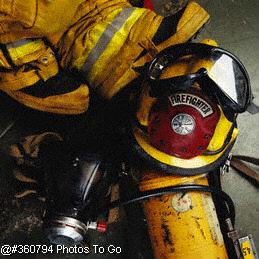
SCBA(Self-Contained Breathing
Apparatus)training:
SCBA training is when you go in groups of 4 or 3, everybody in the group puts on full Bunker Gear and their
SCBA (air tank and mask). Then you and the other 3 or 2 in your group crawl through a tunnel that is pitch black and you have
to hang on to a hose at all times and that will help you find your way around in the tunnel. While your crawling through this
tunnel you have to hang on the hose and the boot of the person in front of you, you also have to stop and check once in a
while to make sure every ones okay and with the group. The whole time your crawling through the tunnel you breathe using your
SCBA and when you "hit" the end of the tunnel you have to check and see that every ones okay and made it to the end then you
turn around and go back. To find out what an SCBA and/or Bunker Gear is look at the bottom of this page.

Above is a picture that was taken through a Termal Imager (explained in the text below), this is a picture
of a firefighter (not Albert Lea, MN) sitting on his/her knees in full bunker gear looking at a piece of paper.
Thermal Imaging training (search
and rescue training in non-smoke house):
Everyone is in full bunker gear, but you dont need to wear an SCBA for this training. The A.L. Fire Fighters take and
hide anywhere from 2-5 other fire explorers. You go in teams of 2, you have to crawl around, you cant stand-up or walk cause
in a real fire the firefighters cant stand-up they have to crawl. The house is pitch black and there is furniture and other
stuff like wood, etc. on the floor. One person has the Thermal Imager (their in front), and the other person has the nozzle
to the hose. If you are the nozzle man, you have to carry the nozzle of the hose with you at all times cause it will
lead you back to the door, you also hang-on to the boot of the person in front of you otherwise youll get lost. The Thermal
Imager will show you where doors, objects and people are that you cant see cause its pitch black. After you find someone you
have to make contact with them and then go find the other people (the firefighters will tell you how many people are in the
house). After you have found all of the people you follow the hose back to the door.

Search and Rescue training
(in smoke house):
First of all, one of the firefighters fills the house with smoke, so much smoke that you cant even see your
hand in front of you. The house has furniture since; if it were a real fire the house would have furniture in it. So, you
have to be careful and try not to hurt yourself. Everyone is in full bunker gear, but you only have to wear an SCBA when its
your groups turn to go in. You are in groups of 3 people, not more or less than 3. They take one fire explorer (that
isnt going in at this time) and hides that person in the house. They are in full bunker gear but dont need an SCBA cause that
would make it harder to carry them out and you can breathe in this smoke so, they dont need one. Person 1 in your group takes
the nozzle and holds on to it at all times, cause you can then follow the hose back to the door and you wont get lost, they
have a flash light attached to their jacket, they are in front. Person 2 (behind person 1) does not have a flash light, they
hang-on to person 1s outside boot in other words they hang on to person 1s boot but are beside them not next to them, then
that way while person 1 is checking near the wall for someone, person 2 can be checking near the middle of the floor. Person
3 has a flashlight attached to their jacket just like person 1 does; they hang on to person 2s outside boot. You follow the
wall all the way around in the room. You have to keep on checking to make sure everyone is still together. When you finally
find the victim, persons 2&3 each put their arm (not wrist) under one of the victims shoulders and one of the two says
1-2-3-LIFT. While youre doing that person 1 drops the nozzle and guides persons 2&3 (with the victim) to the door. When
you reach the door, person 1 moves to the back and they grab the victims feet, while persons 2&3 still have a hold of
the shoulders. Once again someone yells, 1-2-3-LIFT and all together you lift the victim to safety.

Hose Racing:
Hose racing
is more like a game. What we do is we have 4 groups of 3, and 2 teams race at a time. Everybody in all 4 groups has to be
wearing full bunker gear and then you race against the other team. You have to run and grab your teams' hose and you have
to weave it around the cones without knocking-down the cones (if you knock-down the cones your disqualified) when you reach
the end everybody on your team has to hold on to the hose and then you yell, "Charge 1 (or 2 which ever one you are)" and
they open your teams' valve and you have to knock-down the cup with the water before the other team. It's lots of fun and
teaches you teamwork.

Ride-A-Longs:
Ride-a-longs
are when you sign-up to come work with A.L. Fire Fighters for a day and if they go out on a call you can go with them and
help them or if you don't want to go out on that call you can stay at the station. You're at the fire dept. with the fire
fighters from 8:00 am - 10:00 pm. Or any time slot in between 8 a.m. and 10 p.m. But not anytime before 8 a.m. or after
10 p.m. In order to be able to do ride-a-longs you first have to complete the training (bunker gear, identification of different
tools the firefighters use and where they are in the trucks, know how to wash hoses, you have to understand the chain of command,
you have to pass the safety test with 100%) then you have to complete 25 hours of community service (Brad, Greg, Scott or
Lee will tell you when community service/work comes up) and you must complete at least 25 hours of training. Then you
have to pass all the tests with 100%, tests include: hydrant test, bunker gear/SCBA test, equipment test, and a written test.
Even after your able to do ride-a-longs you still have to complete at least 48 hours of community service a year. Also, when
you sign up to do a ride-a-long you can only sign up for one at a time then when you complete that one you can sign up for
another one. You also must sign up at least a week in advance so the shift captain knows about it and they have to approve
of it (you have to ask the shift captain). Only one explorer can be doing a ride-a-long at a time.

Above is a picture of the Farmland Foods fire Albert Lea, MN had in July of 2001. We had to get help from
lots of other fire departments around southern Minnesota. The fire lasted for about 3+ days. A few days after we finally got
the fire put out another smaller fire brokeout.
Callbacks:
Once you've completed
all the training necessary to do ride-a-longs, have completed at least 75 hours of ride-a-longs, know how to refill
the air tanks, are 16 or older (so, you can drive to the fire dept.) and pass the callback test...you will get a pager
that coded with a specific fire department shift (either, red, blue or green shift). And every time that shift that your pager
is coded with gets called back to the fire station you know about it, and what's going on and you can go back the fire station.
If youre in the fire station because the pager shift you had got called back into the station and they go out on a fire call
you can go with them too. You also refill the air tanks. The reasons the shift may get called back in are...the other shift
that was on duty got called out to a fire and it's a roaring fire, so, it might take them awhile, another shift might get
called back in, so if there's another fire call while that other shift still out at the fire the shift that got called back
in will go to that fire call. If they get a house fire they will do a callback right when they arrive. Another reason is that
the fire got too big for that one shift or their unable to control it, so they might call in another or two shift(s) to help
with the fire.
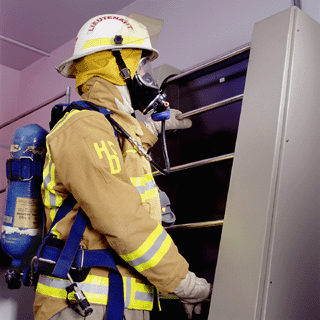
Above is a photo of a firefighter (not Albert Lea) he has on a jacket, boots, pants, helmet,
and gloves. All that is Bunker Gear. He also has on an air tank which is hooked to the mask he is wearing. All that is called
the Self-Contained-Breathing-Apparatus, or SCBA for short. Which is not to be confused with the Breathing Apparatus divers
use, which is SCUBA, Self-Contained-Underwater-Breathing-Apparatus.
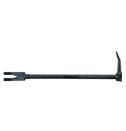
Above: picture of a Halligan Bar

 |